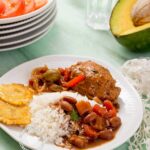Constipation, characterized by infrequent bowel movements and discomfort, is a common digestive concern. Fortunately, dietary fiber is a powerful ally in promoting regular bowel movements and overall digestive wellness. This guide provides a helpful high-fiber foods chart specifically designed to aid constipation relief, offering a practical approach to incorporating fiber-rich foods into your diet for improved digestive health.
Understanding Constipation and Why Fiber Helps
Constipation occurs when waste moves too slowly through the digestive tract, making stools hard, dry, and difficult to pass. While occasional constipation is often not a cause for concern, chronic constipation can significantly impact your quality of life and overall well-being.
Several factors can contribute to constipation, including:
- Medications: Certain medications can have constipation as a side effect.
- Sedentary Lifestyle: Lack of physical activity can slow down bowel function.
- Dehydration: Insufficient fluid intake can harden stools.
- Low-Fiber Diet: Inadequate fiber intake is a primary dietary cause of constipation.
- Irritable Bowel Syndrome (IBS): This condition can manifest with constipation.
- Pregnancy: Hormonal changes during pregnancy can affect bowel movements.
- Travel: Changes in routine and diet while traveling can disrupt bowel regularity.
- Sleep Pattern Changes: Irregular sleep can impact digestive rhythms.
Beyond physical discomfort, chronic constipation has been linked to mental health concerns like anxiety and depression, and may contribute to systemic inflammation. Furthermore, persistent constipation can lead to physical complications such as hemorrhoids and anal fissures. Increasing your fiber intake through diet is a natural and effective strategy to address and prevent constipation, fostering a healthier digestive system.
The Power of Fiber for Digestive Health
Fiber, often referred to as roughage or bulk, is a unique component of plant-based foods. Unlike other food components, fiber is not digested by the body. Instead, it passes relatively intact through your digestive system, playing several crucial roles in maintaining digestive health.
Fiber benefits digestive health in several ways:
- Increases Stool Bulk: Fiber absorbs water in the intestines, adding bulk to the stool. This bulk stimulates bowel contractions, helping to move waste through the digestive tract more efficiently and making stools softer and easier to pass.
- Regulates Digestion Rate: Fiber can slow down the digestion of food, which helps regulate blood sugar levels and promotes a feeling of fullness, which can be beneficial for weight management.
- Nourishes Gut Bacteria: Fiber acts as a prebiotic, feeding the beneficial bacteria in your gut. A healthy gut microbiome is essential for overall health, including optimal digestion and immune function.
While fiber supplements are available, obtaining fiber from whole foods is generally recommended. Whole foods offer a broader range of nutrients and fiber types, maximizing digestive benefits and overall nutritional intake.
High-Fiber Foods Chart for Constipation
The following high-fiber foods chart provides a practical guide to incorporating fiber-rich options into your diet to relieve constipation. This chart highlights various foods, their serving sizes, and the corresponding grams of fiber they contain, making it easy to choose and plan your high-fiber meals.
| Food | Serving Size | Grams of Fiber |
|---|---|---|
| Artichoke, cooked | 1 cup | 9.8 grams |
| Avocado | 1/2 cup | 5.5 grams |
| Banana | 1 large | 3.5 grams |
| Blueberries | 1 cup | 6.2 grams |
| Broccoli, cooked | 1 cup | 5.2 grams |
| Cauliflower, cooked | 1 cup | 4.9 grams |
| Chickpeas, cooked | 1/2 cup | 6.3 grams |
| Figs, dried | 1/4 cup | 3.7 grams |
| Green peas, cooked | 1 cup | 8.8 grams |
| Kidney beans, canned | 1/2 cup | 5.5 grams |
| Lentils, cooked | 1/2 cup | 7.8 grams |
| Navy beans, cooked | 1/2 cup | 9.6 grams |
| Orange | 1 fruit | 3.1 grams |
| Strawberries, raw | 1 cup | 3.0 grams |
%2520(1).jpeg)
This chart showcases a variety of delicious and readily available foods that can significantly boost your fiber intake. Incorporating these into your daily meals and snacks is a simple yet effective way to promote regular bowel movements and combat constipation naturally.
Sample High-Fiber Meal Plan to Beat Constipation
To help you visualize how to integrate high-fiber foods into your daily routine, here’s a sample meal plan designed to increase your fiber intake and support digestive regularity:
- Breakfast: Oatmeal prepared with water or low-fat milk, topped with a cup of fresh strawberries and a sprinkle of chia seeds. A dollop of low-fat yogurt can add creaminess and probiotics.
- Lunch: A hearty bowl of turkey and vegetable chili, rich in kidney beans and navy beans. Top with half an avocado for extra fiber and healthy fats. Serve with a side of whole-wheat crackers.
- Dinner: Grilled chicken or fish served with generous portions of cooked cauliflower and broccoli. Include a baked sweet potato with a drizzle of olive oil instead of butter for added fiber and nutrients.
Remember, this is just a sample meal plan. Feel free to adjust it based on your preferences and dietary needs, utilizing the high-fiber foods chart to guide your choices. Consulting with a healthcare professional or registered dietitian can provide personalized recommendations for your fiber goals and dietary plan.
Tips for Balancing Fiber Intake and Maximizing Comfort
While increasing fiber intake is beneficial for constipation relief, it’s important to do so gradually. Suddenly overloading your system with fiber can lead to digestive discomfort such as gas, bloating, and stomach cramps, potentially exacerbating your constipation symptoms initially.
Follow these tips for comfortable and effective fiber increase:
- Gradual Increase: Introduce high-fiber foods into your diet slowly over a few days or weeks, allowing your digestive system to adapt.
- Hydration is Key: Drink plenty of water throughout the day, especially as you increase your fiber intake. Water helps fiber work effectively by softening stools and facilitating their passage.
- Listen to Your Body: Pay attention to how your body responds to increased fiber. If you experience discomfort, reduce your intake slightly and gradually increase again as tolerated.
- Variety is Best: Choose a variety of high-fiber foods from the chart to ensure you are getting a range of nutrients and fiber types.
- Consider Supplements (If Needed): If you find it challenging to meet your fiber needs through diet alone, consult your doctor about whether a fiber supplement might be appropriate for you. However, prioritize whole food sources whenever possible.
More Than Just Constipation Relief: Broader Benefits of High Fiber
The advantages of a high-fiber diet extend far beyond just relieving constipation. Numerous studies have demonstrated that incorporating sufficient fiber into your daily meals contributes to a wide array of health benefits, promoting long-term wellness.
Additional benefits of a high-fiber diet include:
- Healthy Weight Management: High-fiber foods are often lower in calories and higher in volume, promoting satiety and helping you feel fuller for longer, which can aid in weight management.
- Improved Blood Sugar Control: Fiber slows down sugar absorption, helping to stabilize blood sugar levels and reducing the risk of type 2 diabetes.
- Lower Cholesterol Levels: Soluble fiber, in particular, can help lower LDL (“bad”) cholesterol levels, reducing the risk of heart disease.
- Reduced Risk of Chronic Diseases: High-fiber diets have been linked to a reduced risk of various chronic diseases, including certain types of cancer and heart disease.
- Increased Longevity: Research suggests that individuals who consume higher amounts of fiber tend to live longer and healthier lives.
Embracing a high-fiber diet is a proactive step towards improving not only your digestive health but also your overall well-being. Whether you are actively seeking constipation relief or simply aiming to enhance your health, incorporating fiber-rich foods is a valuable and sustainable dietary strategy.

